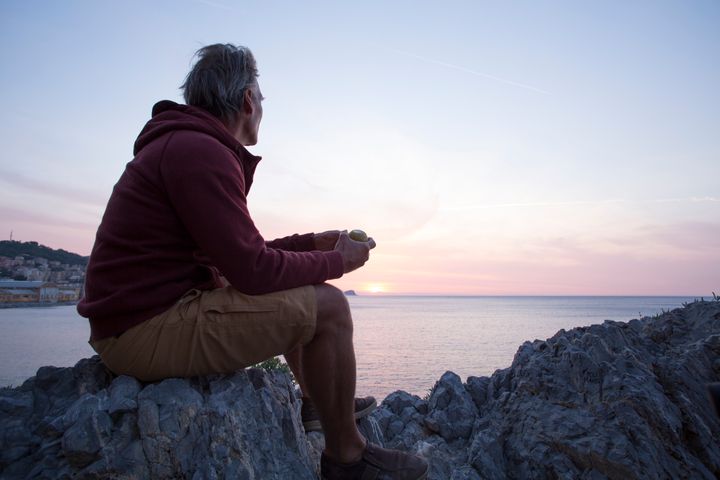News
Feeling Anxious? Therapists Say This 1 Thing Can Calm You Down.
No matter how many times you deal with anxiety or stress in your life, it can feel really hard to look forward to better, calmer moments.
There isn’t just one way to cope with anxiety and stress. Instead there are a host of options for dealing with these emotions — from exercise to mindfulness to medication and more. That said, therapists told HuffPost there’s one activity you may not be doing when feeling stressed or anxious: considering your eye gaze.
“When we are in an activated nervous system state, or in fight/flight, the eyes may protrude and be fixed on one spot ― also known as tunnel vision,” Justine Grosso, a somatic psychologist licensed in New York and North Carolina, told HuffPost via email.
Just think about it: your eyes regularly narrow when you’re upset or you may find yourself squinting at the screen while prepping for a big meeting.
“Visual stimuli [is] the information we process the most quickly … when we’re experiencing the world, our eyes are our most dominant sense,” said Danica Harris, a somatic therapist and coach based in Texas. “So, if there’s been trauma or stress, the eyes become very fixed and narrow in focus, because essentially, what’s happening is … you start looking at the environment in a way of like, where’s the next stressor?”
It’s easy to see how unknowingly being prepped for the next stressor would cause both physical and mental discomfort. Experts say there is one thing you can do to combat this on-the-defensive eye positioning. Here’s what it is:
You should regularly soften your gaze.
The eyes can naturally carry a lot of pressure, said Harris, especially for someone who’s experienced stress or trauma. What’s more, as part of our fight or flight survival, our attention naturally goes to things we perceive as threats, Grosso noted.
To combat this instinct, you need to give your eyes permission to relax when you’re in safe environments. You can do this by softening your gaze, which is when you let your eyes exist in the eye socket without pressure, Harris explained.
“And what that might look like is tuning out all visual stimuli, or it might look like gently gazing around your environment,” Harris said.
You can do this by cupping your hands over your eyes to block out all of the visual stimuli around you, she noted. “You could do that for 30 seconds, you could do that for a minute,” Harris said.
She often recommends her clients do this every hour. “And normally what people will report after they do that is that they have less tension in their forehead .. when we have less tension in our forehead, we’re likely to have less tension in our jaw, when we have less tension in our jaw, we’re likely to have less tension in our neck.”
You can also soften your gaze by looking around your environment, whether you’re in your home or out in nature, Harris noted. When softly looking around your environment, your eye gaze becomes more fluid as opposed to focused and narrowed on something specific, like a laptop screen or phone, she said.
Harris recommends softly gazing into a field or forest, lake or ocean, or even throughout your home. “When our eye gaze is more fluid, what we’re likely to notice is that we’re not having as much tension in our body,” Harris said.
You can also choose to look at things that feel good to look at, Grosso added. “Exploratory orienting can help you shift from an activated state in the nervous system to a calmer state.”
Ascent/PKS Media Inc. via Getty Images
Visual cues can help you practice mindfulness, too.
“When we think about the neurobiology of feeling safe, of self-regulation, of social engagement, we know that’s not just something that we can think out loud and say, ‘I am safe,’ or ‘I feel well,’ … our body doesn’t necessarily always follow that statement,” said Meghan Watson, the founder and clinical director of Bloom Psychology & Wellness in Toronto.
When trying to feel these thoughts you have, it can be helpful to use your physical senses, she said. “I use eye gaze a lot as a way to get people grounded into mindfulness,” said Watson.
Visual cues are a core part of a common grounding exercise known as the 5-4-3-2-1 technique, added Watson. For this mindfulness practice, you name five things you can see, four things you can hear, three things you can touch, two things you can smell and one thing you can taste.
“Really narrowing your focus to the body [and] starting with the eyes because visual stimuli is such a powerful, soothing component,” she said.
The 5-4-3-2-1 technique is a way to get yourself back in the present moment and away from any negative emotions, Watson noted.
You don’t have to have a set mindfulness practice to try out this eye-orienting technique, either.
“You can use exploratory orienting anywhere, whether you’re alone or with others,” Grosso said. “You can practice orienting by taking the time to intentionally find things to look at that evoke a sense of joy, awe or warmth … or by systematically looking to your right, left and behind you to really see that you are in a safe location and that there are no imminent threats.”
Harris added that these practices can (and should) be done before you’re dealing with stress and anxiety, too. This way, you’ll be better prepared to deal with stress and anxiety when they inevitably show up.
Self-care doesn’t have to wait for a bad situation. “We could begin a somatic practice today that actually helps us to feel a lot better in our bodies and really treat our bodies like our one true home,” Harris said.

